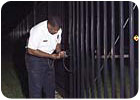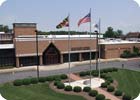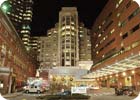During the Night

Security Officer Bob Marshall secures a gate on the perimeter fence at the Johns Hopkins University Applied Physics Laboratory, Laurel, Md. Photo courtesy of Johns Hopkins Applied Physics Laboratory
Securing any type of business during the day often means using a combination of technology and people to monitor who goes in and out of the building. But at night, the needs can be very different. That is why many facilities have a nighttime security protocol that differs from the daylight hours.
“Obviously you have different factors,” says Tom Clancy, president of Acree Daily Integrated Systems Inc., Columbus, Ohio. “Your nighttime surveillance is looking away from your common access points. During the day you are watching the access of gates, doors, driveways, etc. At night, you are typically monitoring away from those areas and looking for anyone approaching over a fence or around the back side of a premises.”
The very fact that it is dark outside can be a hindrance to security and a boon to potential threats. “The inherent nature of nighttime is that things are not as visible,” says Bonnie Michelman, CPP, CHPA, director of police, security and outside services for Massachusetts General Hospital. “There are more places people can hide. At night there are fewer people working. Patients are sleeping so they are in vulnerable positions.”
While the threats differ, the basic premise does not. At night there are fewer people around, and more opportunity for crime. “People being onsite is the biggest difference,” says Brandon Buffin, systems administrator for Kentucky-based home builder, Ball Homes. “During the day you are not as likely to have a security event with the people and lights there.”
Clancy agrees. “Nighttime is when you have people breaking in and stealing from office buildings, distribution centers, etc.”
RISK ASSESSMENT
Whether for day, night or all-around security, the best starting place for any facility is to perform a good risk assessment.As one of the largest hospitals in the country, with 22,000 employees and 5.5 million square feet of space, Massachusetts General has a lot of ground to cover. Michelman says risk assessments are one key to her success.
“Any kind of risk assessment will look at the demographics of an area. Most of the time in an urban setting like ours, there is more crime at night. There are fewer people around and more crime in general. That is why we take additional safeguards by having more restricted access at night.
“We do risk assessments constantly and determine a multitude of ways, whether procedures or programs or technology, that allow us to enjoy an extraordinarily low rate of incidents for a hospital this size.”
These risk assessments are crucial, Clancy adds. “One of the most important things we have learned is to do a very detailed assessment and build the security into the facility, as opposed to attempting to retrofit security into the facility. The most important thing is to understand that you do have different requirements at night than you do during the day. Do an assessment at night and build those requirements in.”
“NATURAL” SECURITY
The good news for many facilities is that nighttime security doesn’t have to require a whole different range of technology and products. In fact, some of the most effective nighttime deterrents to crime are extremely low-tech and can work both individually and in concert with your existing technologies, such as cameras and access control.“Sometimes it just requires a better system of checking when light bulbs are out, or checking that there is equitable lighting throughout,” Michelman says. “Lighting is one of the most effective ways to deter crime. It’s enormous.”
At Johns Hopkins University Applied Physics Lab in Laurel, Md., they have learned this lesson well. As the largest employer in the county, with 4,000 employees, the physics lab is mostly deserted at night. They primarily rely on officers patrolling the grounds for their nighttime security.
“We haven’t had any major incidents,” says Donald Evans, section supervisor of physical security for the lab. “Due to lighting and crime prevention through environmental design, we are not looked on as a favorable target to begin with.
“We’ve made real efforts to ensure that we have stand-off at parking, trying to keep people a minimum of 50-100 feet away from the building. We keep perimeters easily viewable. We have a grounds crew that makes sure bushes are kept down and trees are trimmed so cameras can see. We keep the parking lots well lit at night.”
In fact, one of the duties of the nighttime officers at the lab is to report any lights that are out.
That is a good plan, Michelman says. “Facilities may have lights out in parking lots that can destroy or negate good security. Landscaping can allow people to hide behind shrubbery. There may be signage issues, or cameras that may not be working properly or recording.”
It’s always advisable to check the simple things before adding a lot of expense for nighttime security.

There are different security challenges at night. Shown here is the Johns Hopkins University Applied Physics Lab’s main building, called Building 1. Photo courtesy of Johns Hopkins University
TECHNOLOGY OPTIONS
But sometimes this is not enough to secure the particular environment or to deter the criminal element.Buffin tried the lighting approach for his warehouse, but still had problems.
“We have a warehouse that we run new homes maintenance crews out of. It’s in a somewhat secluded area. There are supplies, tools, trucks, some high dollar items. Our biggest nighttime need is securing that area.”
When the lighting he put on the back lot still failed to deter break-ins, Buffin looked to a more high-tech, hands-on option.
“You can have cameras out there, and we did. But coming in and looking at them the next day doesn’t do any good. That person is gone. They have your stuff.”
Buffin turned to Sonitrol of Lexington to not only add security, but monitor it as well. “We now have cameras that Sonitrol monitors for us. We also use motion detectors. What they are looking for is a body moving across our parking lot at 2:00 a.m. when there shouldn’t be.
“We have had this system about six months and have not had an incident in that time frame. That is what we are looking for.”
When it comes to nighttime technology, there are a variety of options, Clancy adds.
“Certainly security video is going to be used with day and night vision. That will typically be mirrored with infrared attempting to notice any change in heat patterns. You may also use intelligent video where you will be looking for any kind of changes in light patterns. You may use license plate ID, which can be done with or without light. You will often have physical guards who will be watching the perimeter. And you will be using access control.”
Michelman definitely uses many of these technologies, she says, and backs them up with good security staffing. “We do use some nighttime cameras. We use full, integrated security technology with sophisticated access control systems, security video, DVRs, intelligent video, panic alarms, etc.
“We certainly also have appropriate lighting conditions throughout our facility at night,” she adds. “And we have certain methodologies for our patrols at night. We are able to do some additional functions during the night, such as proactive penetration audits of high risk areas. That might include trying to get into a research lab to make sure the doors are locked. We test the system.”
At Johns Hopkins Applied Physics Lab, many of these types of technologies are in play as well, in addition to the officers, Evans says.
“We have an access control system, which serves to tell us who is in the building. We also use a combination of alarm systems. We alarm all of our sensitive areas, our perimeter entrances. We use security video to monitor our parking lots, our lobbies, our entrances and our vehicle entrances in conjunction with the alarm systems. Finally we have a vehicle patrol out there all night long checking external doors to make sure everything is secure.”
These types of combinations are often the best of both worlds, Clancy adds. “There is always a marriage of technology and physical protection. The physical protection with guard services are there managing the technology.”
And the “natural” elements of lighting and design help augment both officers and technology by allowing them to do their job most effectively.

It’s dark out there. That’s the inherent nature of nighttime security, according to Bonnie Michelman, CPP, CHPA, director of police, security and outside services for Massachusetts General Hospital.
WORDS OF ADVICE
Whether you use guards, technology or high-tech nighttime devices, the key to securing your facility at night is to understand what your needs are and how best to fill them.“There is no formula,” Michelman says. “People need to look at a confluence of factors with trying to have convenience, but good security too. Look at crime prevention through environmental design and continue to look at changing risks and having a system that is flexible.
“I do some consulting as well. And I have seen in some of my travels organizations that don’t always look at some of the simple solutions to having security be effective and be a deterrent.”
Evans adds that using nighttime officers can present a unique set of challenges to be aware of.
“The most important elements are maintaining adequate coverage and making sure officers are alert and understand the importance of their job. It takes a special person to work the night shift. It’s a real challenge to keep them motivated. We try to do it through supervision – we speak with every officer on radio or telephone every 30 minutes to make sure they are awake and nothing has happened to them. We also use reward programs. We recognize them and make them feel a valuable part of the team.”
For Buffin, the key is monitoring. “Someone watching all the time is important, whether that is on-site or a company like Sonitrol, where you can pull up the cameras any time and have immediate dispatch.”
Michelman concludes, “We look at security in a very holistic way. That balance involves well trained, professional, educated staff. Next is state-of-the-art technology designed to fit the risks we have, and third is the policies and procedures that are appropriate for our mission. We may have different patrols at night, and some of our systems may be used differently at night. But each component of that balance still exists at night as during the day.”
Looking for a reprint of this article?
From high-res PDFs to custom plaques, order your copy today!


